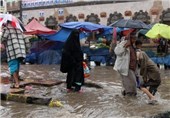Yemen's UNESCO-Listed Old Sana’a Houses Collapsing in Heavy Rains
TEHRAN (Tasnim) – The houses in Yemen's UNESCO-listed Old City of Sana’a are collapsing due to heavy rains, as months of floods and storms assail a country already reeling from war, food shortages, and disease.
The distinctive brown and white mud-brick houses of Sana’a’s historic neighborhoods, which date from before the 11th century, have long been under threat from conflict and neglect.
Muhammad Ali al-Talhi's house partially collapsed on Friday as heavy rain battered Sana’a, leaving the family, including six women and six children, homeless.
"Everything we had is buried," he said surrounded by ancient debris and mud, appealing for help to find shelter.
Aqeel Saleh Nassar, deputy head of the Historic Cities Preservation Authority, said people were not maintaining these old buildings as they had done in the past, leading to cracks and structural weakening.
Approximately 5,000 of the towering buildings in the old city have leaky roofs, and 107 have partially collapsed roofs, he said.
This year's exceptionally heavy rains, which began mid-April, have added to what the UN describes as the world's worst humanitarian crisis.
Five years of the Saudi-led war have killed more than 100,000 people, left 80 percent of the population reliant on aid and pushed millions to the brink of famine.
In addition, and on top of the new coronavirus that is believed to be spreading largely undetected, heavy rains spread diseases like cholera, dengue fever and malaria.
Houthi authorities appealed this week to UNESCO to save the city's heritage.
They said some 111 houses had partly or completely collapsed in recent weeks.
Sana’a resident Adel San’ani on Saturday told Reuters he saw five severely damaged houses over a two-day period.
“The families have no shelter. A local bank launched a campaign to distribute plastic sheeting to act as roofs,” he said.






